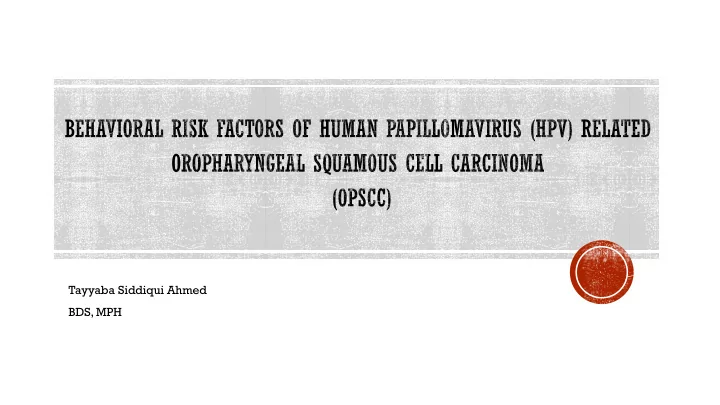

Tayyaba Siddiqui Ahmed BDS, MPH
Human Papilloma Virus head and neck cancer Sixth most common HPV 150 types of viruses Classification: 150 genus Similarities in DNA sequence: (according to similar DNA) mucosal ( α genus) i. High Risk: Low Risk: HPV high risk 16, 18, 31, 33, HPV 6, 11, low risk 34, 35, 39, 45, 40, 42, 43, 44, 51, 52, 56, 58, ii. cutaneous ( β genus) 54, 61, 72, 81, 59, 66, 68, 73 and 89 and 82
HPV – first recognized in 1983 HPV-16 and 18 strains head and neck cancer HPV-OPSCC clinical characteristics Most common sites: Lingual and Palatal tonsils Histopathology – varies according to locations
Global Incidence - 400,000 Mortality -223,000 deaths (International Agency for Research on Cancer – IARC) U.S. Incidence - 49,670 Mortality - 9,700 (American Cancer Society) HPV-16 related OPSCC incidence increasing: Younger adults in USA, Australia, certain European countries* *Ferley J, Shin HR, Bray F, Forman D, Mathers C, Parkin DM. Estimates of worldwide burden of cancer in 2008. Int J Cancer 2010; 127:2893-2917
18 – 70 year olds Males Multiple sex partners Consumers of: tobacco alcohol
Assess the distribution of HPV-OPSCC in different subgroups of the population Investigate the risk factors for HPV related OPSCC
Secondary analysis of 2011–12 NHANES Data Study sample = 5000 Inclusion: 30 – 69 year olds Exclusion: <30 year olds Dependent variable: HPV related OPSCC
Demographics Dental visits Oral cancer examination Smoking and alcohol habits Sexual partners/year
Descriptive Analytic: Bivariate: Chi square, t-tests Multivariate: ANOVA, Logistic regression
Distribution of HPV-OPSCC by sociodemographic factors (N=4566) HPV Oral Cancer p-value Variables Positive Negative *<0.05 Gender Females 488 (10.7) 1839 (40.5) 0.041 * Males 411 (9) 1807 (39.8) Age , mean (sd) 55.23 (±14.57) 54.03 (±15.11) 0.029 *
Association between HPV-OPSCC and Behavioral Factors (N=4566) HPV Oral Cancer p-value Variables Positive Negative *<0.05 Oral Cancer Exam Past year 0.227 572 (49.3) 163 (14.1) 1-3 years ago 186 (16) 50 (4.3) 0.058 * 3 + years ago 135 (11.6) 54 (4.7) Alcohol Use , mean (sd) 66.34 (±102.6) 51.3 (±95.12) 0.000 *
Association between HPV-OPSCC and Behavioral Factors (N=4566) HPV Oral Cancer p-value Variables Positive Negative *<0.05 Multiple Sex Partners Yes 40 (2.2) 175 (9.7) 0.435 No 334 (18.4) 1264 (69.7) Smoking Habits 138 (6.7) 737 (35.9) 0.001 * Yes 257 (12.5) 922 (44.9 ) No
Logistic Regression model for HPV-OPSCC and Risk Factors (N= 4566) p-value c = 0.65 Coefficient *< 0.005 Oral Cancer Examination Past Year 2.37 (1.29 – 4.37) 0.005 * 1-3 years 2.17 (1.02 – 4.59) 0.043 * 3 or more years Ref Multiple Sex Partners 1.15 (0.330 – 4.04) 0.821 Smoking habits 1.98 (1.08 – 3.63) 0.026 * Alcohol use 0.99 (0.99 – 1.00) 0.497 Model was adjusted for age, gender, race, income, and education
Cross-sectional study; no temporal relationship no causality Potential Biases: Reporting Recall
The overall prevalence of HPV-OPSCC was 19.8% The distribution was more common among: Females Smokers Alcohol consumers Relatively recent oral cancer screening had a significant association
Health promotion efforts to avoid existing and new risk factors (smoking, alcohol consumption) Increase awareness, particularly among adolescents
Regular oral cancer screening is recommended http://www.encognitive.com/files/images/oral-cancer-screening-detection-examination.jpg
Questions??
Recommend
More recommend